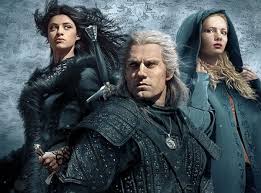The world of The Witcher is in constant conflict. Whether due to a deceptive, shapeshifting monster or a human with the power to cast curses, chaos is prevalent in Polish author Andrzej Sapkowski’s elaborate novels. Netflix’s adaptation of the engrossing book series exhibits the same successful narrative that has also inspired a highly successful video game series of the same name. The Witcher brings a diverse range of character stories to explore, exhilarating battles with uniquely choreographed moves, and an intricate, albeit initially difficult to comprehend, environment to discover.
The first season introduces the viewer to a dystopian world. It is a place riddled with disease, monsters, and psychopaths, needing a powerful figure to protect the vulnerable. The titular ‘witchers’ have the role of establishing such control, with their superhuman agility, strength, and senses enabling them to make a living as monster hunters for hire. Geralt (Henry Cavill) is one such witcher, who, despite being deprived of all emotions, always seeks to uphold his morals by only killing those who possess truly malicious values.
The series also follows Yennefer (Anya Chalotra), a mage well-versed in the use of magic, and Geralt’s love at first sight; and Geralt’s promised child, Princess Cirilla (Freya Allan). Cirilla’s father promised her to Geralt after he saved his life, having nothing else to offer. Yennefer, meanwhile, is the disowned daughter of a farmer who achieves political influence through her gift of magical powers.
The stories of these three individuals are presented in parallel over the course of eight episodes in a narrative that might seem bland to those familiar with the source material and puzzling to newcomers. The Witcher uses the entirety of its first season to establish the context for what is to come, as is necessary for the world is riveting with politics among kingdoms, racism, and, perhaps most importantly, disgust toward witchers.
This disgust, which creates prejudice against witchers for being mutated humans, is a strong theme in the narrative. It demonstrates the close-minded nature of the people in Geralt’s world, who fear whatever is different from themselves. Those who put in the effort to learn more about the world that surrounds these three individuals, however, will find a highly entertaining series of short stories that bring out the best of Sapkowski’s writing and provide the foundation for a second season where the paths of the three main characters will finally intertwine.
What The Witcher lacks in coherence, it makes up for in a plethora of technical elements that breathe life into its world. Wolfgang Stegemann’s meticulously choreographed sword fighting are one of such aspects. Geralt is a skilled sword fighter: He pirouettes and leaps towards his opponent like a dancer. Additionally, Tim Aslam’s eye-catching costume design stands out as one of the show’s strengths. To accompany these two elements is a score, composed by Sonya Belousova and Giona Ostinelli, that immerses the viewer in the setting of a town’s tavern or an epic fight alongside a dragon through its rhythmic drums, symphonic strings, and orchestral vocals.
The Witcher is not a conventional Netflix original show. Its complex narrative gives as much to the audience as they are willing to invest into the story. The excellent choreography, costume design, and score also contributes to the show’s narrative, as Geralt’s fighting techniques and the songs about his great adventures each have their own stories to tell. Once the basics of the narrative are understood, a truly compelling world is presented for the audience to discover.






